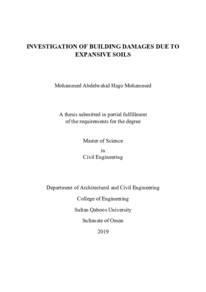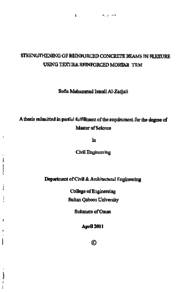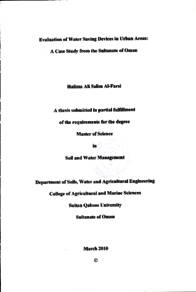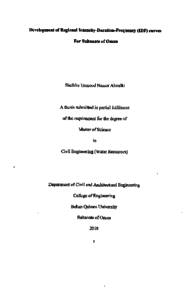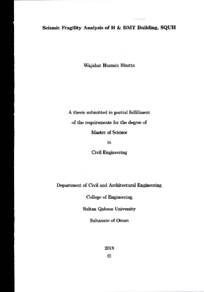Document
Investigation of Building Damages due to Expansive Soils.
Publisher
Sultan Qaboos University
Gregorian
2019
Language
English
Subject
English abstract
Expansive soils swell due to increase in moisture content and shrink when the moisture content decreases. Expansive soils were identified in many locations in Oman causing a severe damage to the buildings. The expansive soil induced damage is more severe in lightweight structures such as residential buildings in Oman which consist of masonry walls supported on shallow foundations. In this study the finite element program (ANSYS) was used to develop a model for analysis of light weight structures.
The lightweight structures consist of masonry walls supported on grade beams and subjected to expansive soil movement. The masonry walls were treated as a linear elastic material using three-dimensional stresses analysis. The model allows for
sliding of walls relative to the beams. In addition, the model allows for debonding of wall panels along a predefined crack. The model predicts the patterns and the width of the cracks that develop in the walls due to soil swelling or shrinkage. The model
was validated by comparison to actual cases of damaged buildings and found to accurately predicts the pattern and magnitude of the actual reported damages to the buildings. Parametric studies were preformed using the model. Many factors were analyzed to determine their influences on the width of the crack. The factors considered are provisions for windows and doors openings, magnitude of heave, pattern of heave, area beneath the building covered by heave, and the flexural stiffness of the building. It has been observed that edge heave causes wider cracks at the bottom of the wall and the center heave causes wider cracks at the top of the wall. The provisions for openings result in smaller cracks. The width of the crack increases with the magnitude of heave. The increments in area covered by heave results in wider cracks. The increases in modulus of elasticity decreases the width of the cracks. The increases in length of the wall results in smaller cracks. The increase in wall height results in wider cracks.
Keywords: Expansive soil, Masonry panel model, Soil-structure interaction, cracking.
Member of
Resource URL
Arabic abstract
تتمدد التربة الانتفاخية بزيادة نسبة المحتوى المائي وتنكمش بنقصان المحتوى المائي. تتواجد التربة الانتفاخية في مواقع عدة في عمان وتسبب أضرار جمة للمباني خاصة المباني الخفيفة مثل المباني السكنية في عمان والتي تتكون من حوائط طابوق خرسانية مستندة على قواعد غير عميقة.
في هذه الدراسة تم استخدام برنامج العناصر المحددة (ANSYS) لعمل نموذج حاسوبي لتحليل المباني الخفيفة المعرض لحركة التربة الانتفاخية. ويتكون النموذج من حائط بناء مستند على أساس شريطي. حيث تم التعامل مع الحائط كمادة مرنة معرضة لاجهادات ثلاثية الأبعاد. يسمح النموذج للحائط بالحركة افقيا على سطح الأساس. وأيضا يسمح النموذج بانفصال جزئي الحائط على طرفي شق محدد المسار مسبقا. يستنبط النموذج موضع وحجم التشققات الناشئة في حائط البناء بسبب انتفاخ أو انكماش التربة.
تم التحقق من صحة النموذج من خلال مقارنته مع حالات حقيقية لمباني متضررة ووجدت مطابقة في الشكل والمقدار للأضرار الفعلية المذكورة بالتقارير. تم دراسة العوامل التأثيرية باستخدام النموذج الحاسوبي حيث تم تحليل عدة عوامل للكشف عن مدى تأثيرها على حجم التشققات بالجدران. تم الأخذ في الاعتبار العوامل مثل فتحات النوافذ والأبواب، مقدار الانتفاخ في التربة، وموقع الانتفاخ، والمساحة أسفل المبنى المتأثرة بحركة التربة، وصلابة المبنى. تمت الملاحظة إلى أن انتفاخ التربة أسفل أطرف الأساس يتسبب في زيادة حجم التشققات عند قاعدة الحائط بينما يتسبب انتفاخ التربة أسفل الأساس في زيادة حجم التشققات عند قمة الحائط وجد أن النوافذ والأبواب بالحائط يقلل من حجم التشققات. كما أن حجم التشققات يزيد بزيادة مقدار الانتفاخ. وتمت الملاحظة أيضا بأن زيادة المساحة المعرضة للانتفاخ أسفل المبنى تزيد من حجم التشققات. وتمت الملاحظة كذلك إلى أن زيادة صلابة الجدار تتسبب في تقليل حجم التشققات. وتمت الملاحظة أيضا أن زيادة طول الجدار يقلل من حجم التشققات بينما زيادة ارتفاع الجدار تزيد من حجم التشققات.
الكلمات المفتاحية: التربة الانتفاخية، نموذج حوائط البناء، تفاعل التربة المباني، التشققات.
في هذه الدراسة تم استخدام برنامج العناصر المحددة (ANSYS) لعمل نموذج حاسوبي لتحليل المباني الخفيفة المعرض لحركة التربة الانتفاخية. ويتكون النموذج من حائط بناء مستند على أساس شريطي. حيث تم التعامل مع الحائط كمادة مرنة معرضة لاجهادات ثلاثية الأبعاد. يسمح النموذج للحائط بالحركة افقيا على سطح الأساس. وأيضا يسمح النموذج بانفصال جزئي الحائط على طرفي شق محدد المسار مسبقا. يستنبط النموذج موضع وحجم التشققات الناشئة في حائط البناء بسبب انتفاخ أو انكماش التربة.
تم التحقق من صحة النموذج من خلال مقارنته مع حالات حقيقية لمباني متضررة ووجدت مطابقة في الشكل والمقدار للأضرار الفعلية المذكورة بالتقارير. تم دراسة العوامل التأثيرية باستخدام النموذج الحاسوبي حيث تم تحليل عدة عوامل للكشف عن مدى تأثيرها على حجم التشققات بالجدران. تم الأخذ في الاعتبار العوامل مثل فتحات النوافذ والأبواب، مقدار الانتفاخ في التربة، وموقع الانتفاخ، والمساحة أسفل المبنى المتأثرة بحركة التربة، وصلابة المبنى. تمت الملاحظة إلى أن انتفاخ التربة أسفل أطرف الأساس يتسبب في زيادة حجم التشققات عند قاعدة الحائط بينما يتسبب انتفاخ التربة أسفل الأساس في زيادة حجم التشققات عند قمة الحائط وجد أن النوافذ والأبواب بالحائط يقلل من حجم التشققات. كما أن حجم التشققات يزيد بزيادة مقدار الانتفاخ. وتمت الملاحظة أيضا بأن زيادة المساحة المعرضة للانتفاخ أسفل المبنى تزيد من حجم التشققات. وتمت الملاحظة كذلك إلى أن زيادة صلابة الجدار تتسبب في تقليل حجم التشققات. وتمت الملاحظة أيضا أن زيادة طول الجدار يقلل من حجم التشققات بينما زيادة ارتفاع الجدار تزيد من حجم التشققات.
الكلمات المفتاحية: التربة الانتفاخية، نموذج حوائط البناء، تفاعل التربة المباني، التشققات.
Category
Theses and Dissertations

